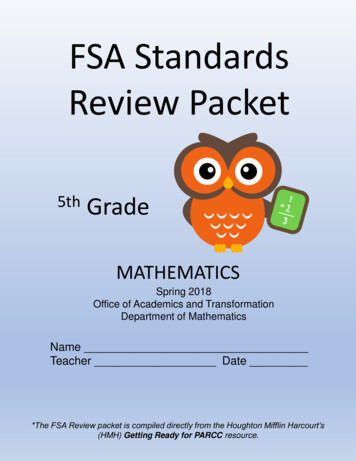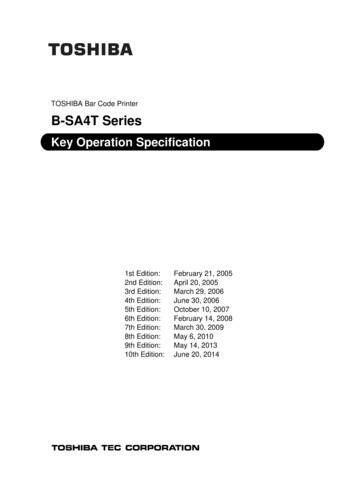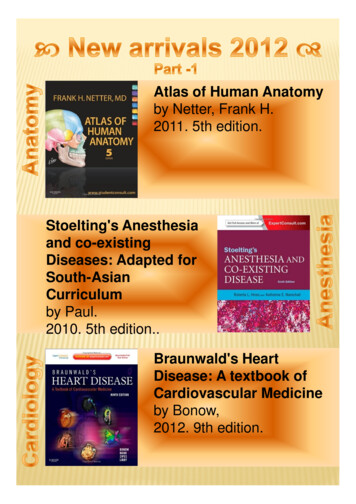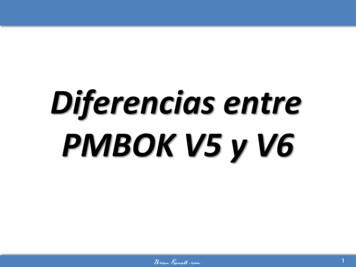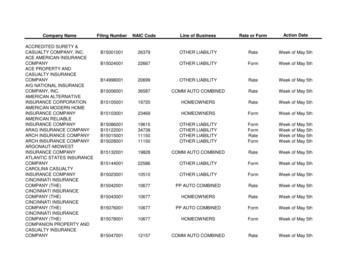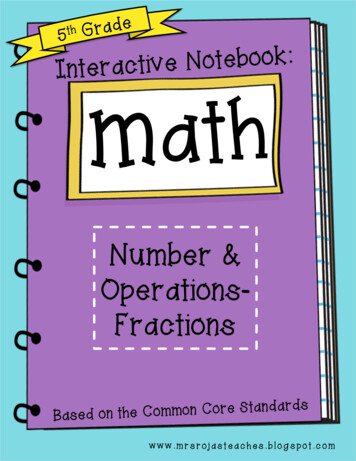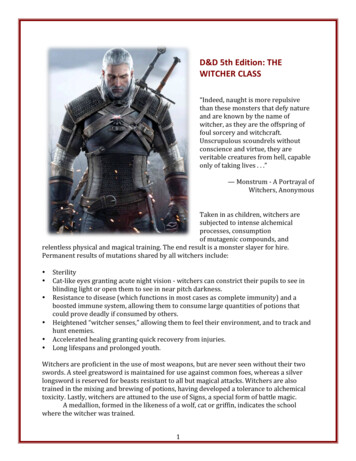
Transcription
D&D 5th Edition: THEWITCHER CLASS“Indeed, naught is more repulsivethan these monsters that defy natureand are known by the name ofwitcher, as they are the offspring offoul sorcery and witchcraft.Unscrupulous scoundrels withoutconscience and virtue, they areveritable creatures from hell, capableonly of taking lives . . .”— Monstrum - A Portrayal ofWitchers, AnonymousTaken in as children, witchers aresubjected to intense alchemicalprocesses, consumptionof mutagenic compounds, andrelentless physical and magical training. The end result is a monster slayer for hire.Permanent results of mutations shared by all witchers include: SterilityCat-like eyes granting acute night vision - witchers can constrict their pupils to see inblinding light or open them to see in near pitch darkness.Resistance to disease (which functions in most cases as complete immunity) and aboosted immune system, allowing them to consume large quantities of potions thatcould prove deadly if consumed by others.Heightened “witcher senses,” allowing them to feel their environment, and to track andhunt enemies.Accelerated healing granting quick recovery from injuries.Long lifespans and prolonged youth.Witchers are proficient in the use of most weapons, but are never seen without their twoswords. A steel greatsword is maintained for use against common foes, whereas a silverlongsword is reserved for beasts resistant to all but magical attacks. Witchers are alsotrained in the mixing and brewing of potions, having developed a tolerance to alchemicaltoxicity. Lastly, witchers are attuned to the use of Signs, a special form of battle magic.A medallion, formed in the likeness of a wolf, cat or griffin, indicates the schoolwhere the witcher was trained.1
It is a common belief that witchers have no capacity for emotion. This perception isdue largely, in part, to the rigorous training and seclusion from society, which has beenknown to result in blunted emotional expression.THE WITCHERLevelProficiency th13th14th15th16th17th18th19th20th 2 2 2 2 3 3 3 3 4 4 4 4 5 5 5 5 6 6 6 6Witcher SensesBattle MeditationAlchemy, Combat CastingAbility Score ImprovementExtra AttackAbility Score ImprovementAard and Igni UpgradesAbility Score ImprovementAdvanced AlchemyYrden and Igni UpgradesExtra Attack (2)Ability Score ImprovementAard and Igni UpgradesAbility Score ImprovementIgni UpgradeAbility Score ImprovementAxii UpgradeSuperior AlchemyAbility Score ImprovementExtra Attack (3)CLASS FEATURESHIT POINTSHit Dice: 1d10 per levelHit Points at 1st Level: 10 your Constitution modifierHit Points at Higher Levels: 1d10 (or 6) your Constitution modifier per level after 1stProficienciesArmor: All armorWeapons: Simple weapons, martial weaponsTools: NoneSaving Throws: Constitution, WisdomSkills: Insight, Intimidation, Investigation and PerceptionSpecial: Resistance to disease, witcher senses, battle meditation2
You start with the following equipment: Suit of chain or leather armor Silver longsword (1d8 1) Steel greatsword (2d6) Light crossbow and 20 bolts Bestiary of Monsters Alchemical toolsWitcher SensesYou have low light vision and your proficiency bonus is doubled for Investigation andPerception.Battle MeditationStarting at 2nd level, you treat short rests as you would a long rest.AlchemyStarting at 3rd level, you gain the ability to create alchemical concoctions for your sword,giving you advantage on your attack rolls against a specific creature. To create the solution,you must first harvest the creature’s organs, and then spend 1 gold piece per the creature’shit dice to gather the necessary ingredients. New solutions require a day to prepare, afterwhich time you may enhance your weapons after a short rest. You may only enhance yourweapons with one solution at a time. The solution dissipates after a day.Advanced Alchemy: At 9th level, choose any creature with 9 hit dice or less that you haveharvested. Against the creature, you have advantage on your attack rolls.Superior Alchemy: At 18th level, choose one creature type. Against creatures of that typewith 18 hit dice or less that you have harvested, you have advantage on your attack rolls.SIGNSStarting at 3rd level, you learn to use Signs, or glyphs, to create a variety of magical effects.Signs work like Cantrips, in that there is no limit to how many you can cast per day.Combat CastingIn combat, you must focus on the Sign you wish to use for the time required. You may notattack or take any other actions during this period. If you take damage or suffer anyadverse effect while you are focusing, you lose your focus and must begin again at the startof the following round.You use your Wisdom modifier when setting the saving throw DC for a witcher sign. Signsave DC 8 your proficiency bonus your Wisdom modifier.3
QUENFocus Time: 2 roundsRange: SelfDuration: 1 minute or until brokenThe Sigil of Protection. Creates a force field around you, absorbing incoming energy, kineticor otherwise, equal in damage points to your level your Wisdom modifier. For instance, at3rd level and with a 2 bonus for Wisdom, Quen absorbs 5 points of damage. So if an attackagainst you would normally deal 8 points of damage, you would take only 3. Once theprotective barrier takes damage, it is broken and must be recast.IGNIFocus Time: 1 roundRange: Self (15-foot cone)Duration: InstantaneousThe Sigil of Combustion. Works as the spell Burning Hands. As you hold your hand out, a thinsheet of flames shoots forth from your outstretched fingertips. Each creature in a 15-footcone must make a Dexterity saving throw. A creature takes 3d6 fire damage on a failedsave, or half as much damage on a successful one. The fire ignites any flammable objects inthe area that aren’t being worn or carried. At 7th level, Igni deals 4d6 fire damage, at 10thlevel 5d6 damage, at 13th level 6d6 damage and at 15th level 8d6 damage.AARDFocus Time: 1 roundRange: Self (10-foot cone)Duration: InstantaneousThe Sigil of Force. You push opponents away from you with magical force. Enemies mustmake a saving throw vs. your spell casting ability or be stunned for one round. The Aardsign can also be used to topple objects, break through barriers, or knock flying enemies tothe ground. Starting at 7th level, enemies failing their saving throws against Aard fallprone. At 13th level, enemies are knocked prone and stunned.4
YRDENFocus Time: 1 roundRange: Self (15-foot radius)Duration: 1 minuteThe Sigil of Containment. Yrden creates a circle of magical glowing glyphs on the ground ina 15’ radius. Enemies walking into the circle must make a successful saving throw vs. yourspell casting ability or become slowed for one minute.Starting at 10th level, Yrden can also turn invisible creatures visible and make noncorporeal enemies vulnerable to non-magical weapons when standing within the glyphcircle. Moving in and out of the circle takes one action.AXIICasting Time: 1 action (charm) 1 round (confusion / dominate person)Range: 30ft (charm/dominate person) 10-foot radius sphere (confusion)Duration: 1 hour (charm) 1 minute (confusion) 10 minutes (dominate person)The Sigil of Persuasion. Identical to the spell Charm Person. You attempt to charm ahumanoid you can see within range. It must make a Wisdom saving throw, and does sowith advantage if you or your companions are fighting it. If it fails it is charmed by you untilthe spell ends or until you or your companions do something harmful to it. The charmedcreature regards you as a friendly acquaintance. When the spell ends it knows it has beencharmed.At 7th level, the Axii sign can be used as the spell Confusion. This spell assaults andtwists creatures’ minds, spawning delusions and provoking uncontrolled actions. Eachcreature in a 10-foot-radius sphere centered on a point you choose within range mustsucceed on a Wisdom saving throw when you cast this spell or be affected by it.An affected target can’t take reactions and must roll a d10 at the start of each of its turns todetermine its behavior for that turn.d10 Behavior1. The creature uses all its movement to move in a random direction. To determine thedirection, roll a d8 and assign a direction to each die face. The creature doesn’t take anaction this turn.2-6. The creature doesn’t move or take actions this turn.7-8. The creature uses its action to make a melee attack against a randomly determinedcreature within its reach. If there is no creature within its reach, the creature does nothingths turn.9-10. The creature can act and move normally.At the end of its turns, an affected target can make a Wisdom saving throw. If it succeeds,this effect ends for that target.5
At 17th level, the Axii sign can be used as the spell Dominate Person. You attempt tobeguile a humanoid that you can see within range. It must succeed on a Wisdom savingthrow or be charmed by you for the duration. If you or creatures that are friendly to youare fighting it, it has advantage on the saving throw. While the target is charmed, you havea telepathic link with it as long as the two of you are on the same plane of existence. Youcan use this telepathic link to issue commands to the creature while you are conscious (noaction required), which it does its best to obey. You can specify a simple and general courseof action, such as “Attack that creature,” “Run over there,” or “Fetch that object.” If thecreature completes the order and doesn’t receive further direction from you, it defends andpreserves itself to the best of its ability. You can use your action to take total and precisecontrol of the target. Until the end of your next turn, the creature takes only the actions youchoose, and doesn’t do anything that you don’t allow it to do. During this time you can alsocause the creature to use a reaction, but this requires you to use your own reaction as well.Each time the target takes damage, it makes a new Wisdom saving throw against the spell.If the saving throw succeeds, the spell ends.6
D&D 5th Edition: THE WITCHER CLASS “Indeed, naught is more repulsive than these monsters that defy nature and are known by the name of witcher, as they are the offspring of foul sorcery and witchcraft. Unscrupulous scoundrels without conscience and virtue, they are veritable


